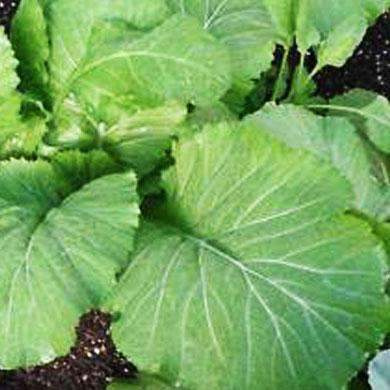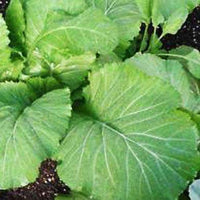
- When to plant:
- Spring, Fall
- Fertilizer:
- Varies
- Seeding rate:
- 5 - 8 lbs. per acre or 1/4 lb. per 100 ft. row
- Overseeding rate:
- 5 lbs. per acre
- Seeding depth:
- 1/2 - 1 inch
- Ideal ph:
- 5.5 - 6.8
- Gmo:
- No
- Inoculant needed:
- No
- Coated or raw:
- Raw
- Lifecycle:
- Annual
- Climate zones:
- Cool Season, Transition Zone, Warm Season
An old southern traditional favorite, “Florida Broadleaf” mustards are perfect to add to any food plot mix from deer to chicken! Most commonly grown for years and years as a staple in southern cuisine. Enjoy these leafy greens cooked on the stove with a ham hock, in a salad or on a sandwich.
Product Information
- Application or Use: Pasture, Food Plot, Livestock Forage, Cattle Grazing, Brassica
- Germination Time: 5 - 7 days, under optimal conditions
- Growing Locations: Warm Season, Transition Zone, Cool Season
- Height: 1 - 2 feet
- Sunlight Requirements: 8+ hours, full sun for best results
- Advantages: Great addition to food plots in Spring, Summer and Fall.
- When to Plant: Recommended planting time is spring, summer and fall when night time temperatures are consistently 65+ degree and 3 months prior to frost.
Broadleaf mustard greens are extremely high in vitamin A, B and C. Pick ‘em early when most tender for the best eatin.’ The older the leaves get they become tough and slightly bitter….but the deer don’t seem to mind!
Hancock’s Broadleaf Mustards boast fast-growing, broad, gorgeous, rich green leaves…each plant is 18-24” tall. To harvest, pick individual leaves and leave the plant to produce more, or harvest entire plant to eat all at once. Plant 4 to 6 weeks before the last average spring frost, or throughout the summer (8 to 10 weeks before first frost). The advantage of late summer sowings is the best mustard flavor occurs after light fall frosts. Spring harvest should be complete before summer heat arrives. Late summer crops will last until the first hard freeze. You can sow mustard seeds in autumn or early winter in mild winter regions.
Hancock’s Broadleaf Mustards are a great addition to food plots for deer. Deer will browse on this leafy green brassica for majority of the year. You can add to your food plots Spring, Summer and Fall.
*Product packaging may appear different than what is pictured.
Planting and Spacing
Grow mustards in full sun or partial shade. Plant mustards in well-worked, well-drained soil rich in organic matter. Add aged compost to planting beds before planting. Mustard prefers a soil pH of 5.5 to 6.8.
Sow mustard as early as 4 to 6 weeks before the average last frost date in spring. Sow succession crops every 4 to 6 weeks. Mustard requires 30 to 40 days to reach harvest. Plant crops so that they come to harvest before temperature average greater than 75°F. Sow mustard in autumn or early winter in mild winter regions. Seeds may be slow to germinate if the soil is too cool, 40°F or less. Mustards grown in hot weather or long days will progress and go to seed quicker.
Sow mustard seed 1/2 in. to 1 in. deep; when seedlings are large enough to handle, thin them from 4 to 8 inches apart; space rows 12 to 24 inches apart.
Watering and FertilizingKeep soil evenly moist to keep leaves growing quickly, do not allow the soil to dry out. Add aged compost to planting beds before sowing if desired. Side dress plants with aged compost at mid season for best results. Keep planting beds weed free. Pull mustards from the garden as soon as it goes to seed to avoid prolific self seeding.
Cooking Mustard Greens
Mustard greens have a peppery-bitter flavor—like mustard. They have long been a favorite american soul food and are used often in indian cookery.
Short cooking is the best way to preserve the flavor and texture of mustard greens. Overcooking will cause greens to become soft and mushy. Match mustard greens with bacon, cheddar cheese, corn, cornbread, curry, garlic, ham, hot sauce, lemon, onion, salt pork, and smoked turkey.
Harvest
Pick individual leaves when they are young and tender, 3 to 4 inches long, or cut and use the entire plant. Complete the harvest before the weather grows hot; hot weather will cause leaves to become tough and strong flavored. Complete the harvest before the plant goes to seed.
When choosing to start a new lawn, remove old vegetation by using a de-thatcher, power rake or tiller to kill the existing vegetation. Rake or drag the area to remove debris and dead grass for a clean area. Ensure the soil is leveled and loosened to allow the seed to have good soil contact once spread on a clean seed bed.
If you have an area with heavy weed coverage, we recommend starting fresh by killing and removing the existing vegetation. If you choose to use chemicals, herbicides or fertilizers, you must check with the product's manufacturer prior to planting new seed to ensure the proper waiting period.
When overseeding an existing area, mow your lawn at the lowest setting and bag the clippingsx. Rake or drag any areas that have dead thatch or debris.

Seed Quality
Hancock Seed is dedicated to delivering the best seeds possible to our customers. Hancock Seed grows and harvests many of our products, and we acquire the majority of the rest from other family farmers.
All these seeds are processed, packaged and shipped from Hancock Farm. This helps us ensure that our high standards are met. Unlike much of the competition, we refuse to sell you a seed that was not gathered during the last harvest. You will always receive fresh product from Hancock.
Every seed we grow comes with 40 years of experience behind it...you can rest assured that all of our products are cultivated in a method that assures its potential for growth.

Your cart ( 0 )

An old southern traditional favorite, “Florida Broadleaf” mustards are perfect to add to any food plot mix from deer to chicken! Most commonly grown for years and years as a staple in southern cuisine. Enjoy these leafy greens cooked on the stove with a ham hock, in a salad or on a sandwich.
Product Information
- Application or Use: Pasture, Food Plot, Livestock Forage, Cattle Grazing, Brassica
- Germination Time: 5 - 7 days, under optimal conditions
- Growing Locations: Warm Season, Transition Zone, Cool Season
- Height: 1 - 2 feet
- Sunlight Requirements: 8+ hours, full sun for best results
- Advantages: Great addition to food plots in Spring, Summer and Fall.
- When to Plant: Recommended planting time is spring, summer and fall when night time temperatures are consistently 65+ degree and 3 months prior to frost.
Broadleaf mustard greens are extremely high in vitamin A, B and C. Pick ‘em early when most tender for the best eatin.’ The older the leaves get they become tough and slightly bitter….but the deer don’t seem to mind!
Hancock’s Broadleaf Mustards boast fast-growing, broad, gorgeous, rich green leaves…each plant is 18-24” tall. To harvest, pick individual leaves and leave the plant to produce more, or harvest entire plant to eat all at once. Plant 4 to 6 weeks before the last average spring frost, or throughout the summer (8 to 10 weeks before first frost). The advantage of late summer sowings is the best mustard flavor occurs after light fall frosts. Spring harvest should be complete before summer heat arrives. Late summer crops will last until the first hard freeze. You can sow mustard seeds in autumn or early winter in mild winter regions.
Hancock’s Broadleaf Mustards are a great addition to food plots for deer. Deer will browse on this leafy green brassica for majority of the year. You can add to your food plots Spring, Summer and Fall.
*Product packaging may appear different than what is pictured.
Planting and Spacing
Grow mustards in full sun or partial shade. Plant mustards in well-worked, well-drained soil rich in organic matter. Add aged compost to planting beds before planting. Mustard prefers a soil pH of 5.5 to 6.8.
Sow mustard as early as 4 to 6 weeks before the average last frost date in spring. Sow succession crops every 4 to 6 weeks. Mustard requires 30 to 40 days to reach harvest. Plant crops so that they come to harvest before temperature average greater than 75°F. Sow mustard in autumn or early winter in mild winter regions. Seeds may be slow to germinate if the soil is too cool, 40°F or less. Mustards grown in hot weather or long days will progress and go to seed quicker.
Sow mustard seed 1/2 in. to 1 in. deep; when seedlings are large enough to handle, thin them from 4 to 8 inches apart; space rows 12 to 24 inches apart.
Watering and FertilizingKeep soil evenly moist to keep leaves growing quickly, do not allow the soil to dry out. Add aged compost to planting beds before sowing if desired. Side dress plants with aged compost at mid season for best results. Keep planting beds weed free. Pull mustards from the garden as soon as it goes to seed to avoid prolific self seeding.
Cooking Mustard Greens
Mustard greens have a peppery-bitter flavor—like mustard. They have long been a favorite american soul food and are used often in indian cookery.
Short cooking is the best way to preserve the flavor and texture of mustard greens. Overcooking will cause greens to become soft and mushy. Match mustard greens with bacon, cheddar cheese, corn, cornbread, curry, garlic, ham, hot sauce, lemon, onion, salt pork, and smoked turkey.
Harvest
Pick individual leaves when they are young and tender, 3 to 4 inches long, or cut and use the entire plant. Complete the harvest before the weather grows hot; hot weather will cause leaves to become tough and strong flavored. Complete the harvest before the plant goes to seed.
Instructions
When choosing to start a new lawn, remove old vegetation by using a de-thatcher, power rake or tiller to kill the existing vegetation. Rake or drag the area to remove debris and dead grass for a clean area. Ensure the soil is leveled and loosened to allow the seed to have good soil contact once spread on a clean seed bed.
If you have an area with heavy weed coverage, we recommend starting fresh by killing and removing the existing vegetation. If you choose to use chemicals, herbicides or fertilizers, you must check with the product's manufacturer prior to planting new seed to ensure the proper waiting period.
When overseeding an existing area, mow your lawn at the lowest setting and bag the clippingsx. Rake or drag any areas that have dead thatch or debris.
















